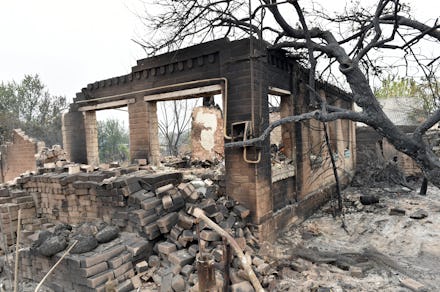Surprise: The government gives more support to richer, whiter neighborhoods after wildfires

Wildfires like the ones that blazed their way through California and much of the West Coast earlier this year are capable of doing devastating amounts of damage — not just to the planet, but to entire communities that fall in the path of the flames. When neighborhoods are lost to these disastrous events, government agencies typically help those affected combat the causes of the fire to limit future damage. A new study published by Resources for the Future found that wealthy, white communities are more likely to get support during these rebuilding efforts than marginalized communities, leaving some of our most vulnerable populations at increased risk.
The study focuses largely on fuel treatment projects, which the federal government often pursues after a fire has damaged a community. Fuel treatment reduces the amount of flammable vegetation in areas that are prone to wildfires. This is done either by mechanical thinning, which cuts and clears out wood and brush that could serve as tinder to flame, or through prescribed fires that burn off existing fuel in a controlled manner before it can accumulate and help feed a wildfire.
Fuel treatment projects are typically expensive, so only a limited number of such projects can actually be carried out each year — a problem as wildfires grow increasingly common and devastating. Because of the prohibitive costs, the government can only perform so many fuel treatment projects each year. As it turns out, according to Resources for the Future, those projects are more likely to happen if the neighborhood near the treatment area is made up of a high percentage of high-income, well-educated, and white residents.
In researching how the government decides where to carry out fuel treatment projects, the researchers examined more than 41,000 census blocks that were within 1.2 miles of a wildfire between the years 2000 and 2011. They found that most neighborhoods were equally unlikely to benefit from the fuel treatment. But wealthier neighborhoods, ones where there were few to no households living below the poverty line, were 40% more likely to receive the benefit of the government project. Predominantly white neighborhoods saw their odds of getting treatment increase by 30% above the baseline.
What the study could not find was a specific reason why this was the case. Officials from the Bureau of Land Management, the Forest Service, and the National Park Service — the three government agencies responsible for the vast majority of fuel treatment projects during the timeframe studied — told The New York Times that race, wealth, and other indicators of socioeconomic status are not considerations when determining where to carry out these fire prevention projects.
One theory raised by Resources for the Future is that these wealthier and whiter communities may be better at lobbying for these projects. They have more money, more access, and in turn more sway among local politicians who are working with the federal government to determine what areas require protection.
Whatever the reason, the results are the same: Marginalized communities are increasingly at risk of not only being affected by wildfires, but also of being left behind in the recovery and left vulnerable to future disasters. In 2018, researchers at the University of Washington found that wildfires disproportionately affect the poor and people of color, in large part because they are not receiving the support they need to protect against fires or rebuild after they hit.
"Many individuals in rural areas, low-income neighborhoods, and immigrant communities do not have access to the resources necessary to pay for insurance, rebuilding, or continual investment in fire safety, thereby increasing their vulnerability to wildfire," the researchers wrote. They found that Black and Hispanic people are about 50% more vulnerable to the effects of wildfires than their white counterparts, and Native Americans were six times as likely to suffer from the impact of these disasters.
Wildfires will likely continue to get more common and more damaging as a result of climate change. Current policies have put vulnerable populations in line of the fires, and recovery plans fall woefully short of helping those communities rebuild and protect themselves. Those disparities must be addressed — or else lower-income households and people of color will continue to bear the burden of these disasters.